Gardeners worldwide are always looking for the newest, flashiest, most amazing plant to add to their collection.
But that stunning thriller of a specimen gets lost without a solid foundation of shrubbery, and no material fulfills this duty better than an evergreen shrub.
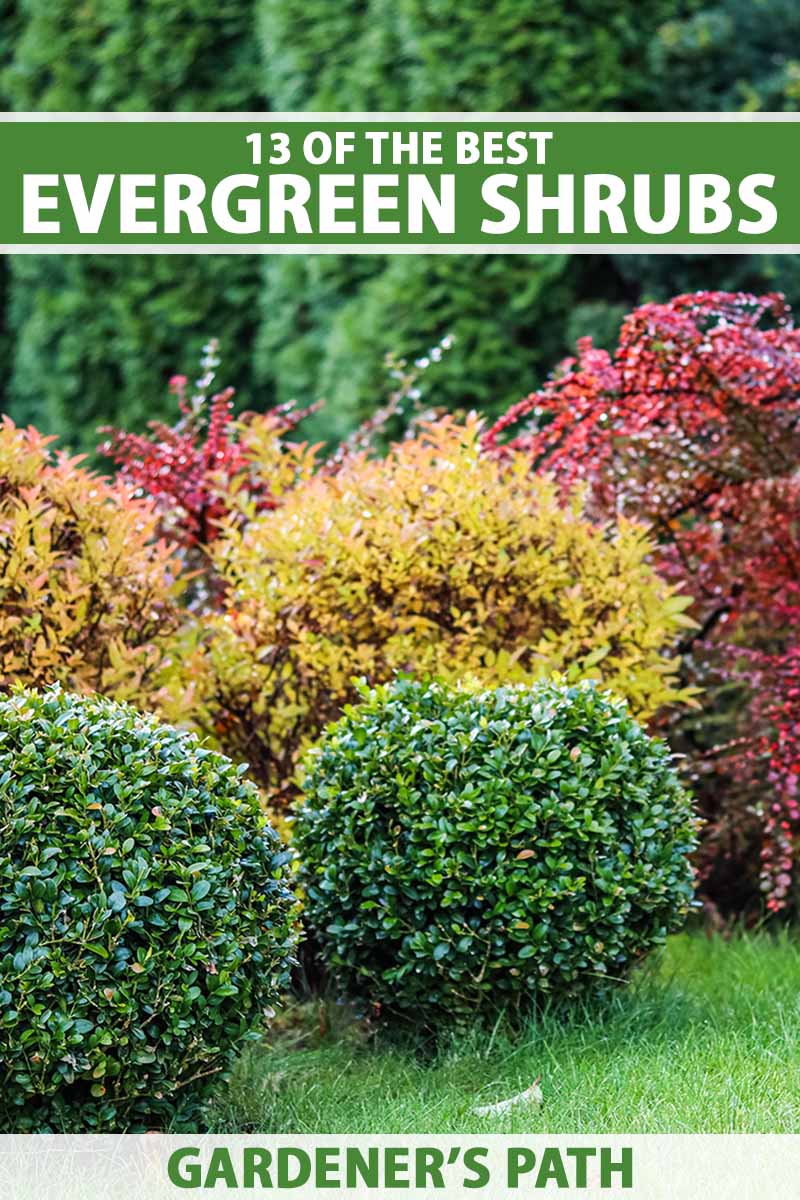
We link to vendors to help you find relevant products. If you buy from one of our links, we may earn a commission.
A reliable and easily maintainable foundation for your garden is a few evergreen shrubs away, so let’s cut to the chase and start talking shrubbery!
Here’s what we’ll cover:
Wait, What Is a Shrub?
Good question! Unfortunately for everybody, the standard definition of a shrub is, “a woody plant smaller than a tree with multiple stems near the ground.” That leaves a lot to be explained!

Let’s skip all of that and assemble our very own idea of what constitutes an evergreen shrub:
- Less than 15 feet in height
- Multiple stems growing from the same point in the ground
- Responds well to pruning and maintenance
- Has year-round foliage
There we go, that’s much better!
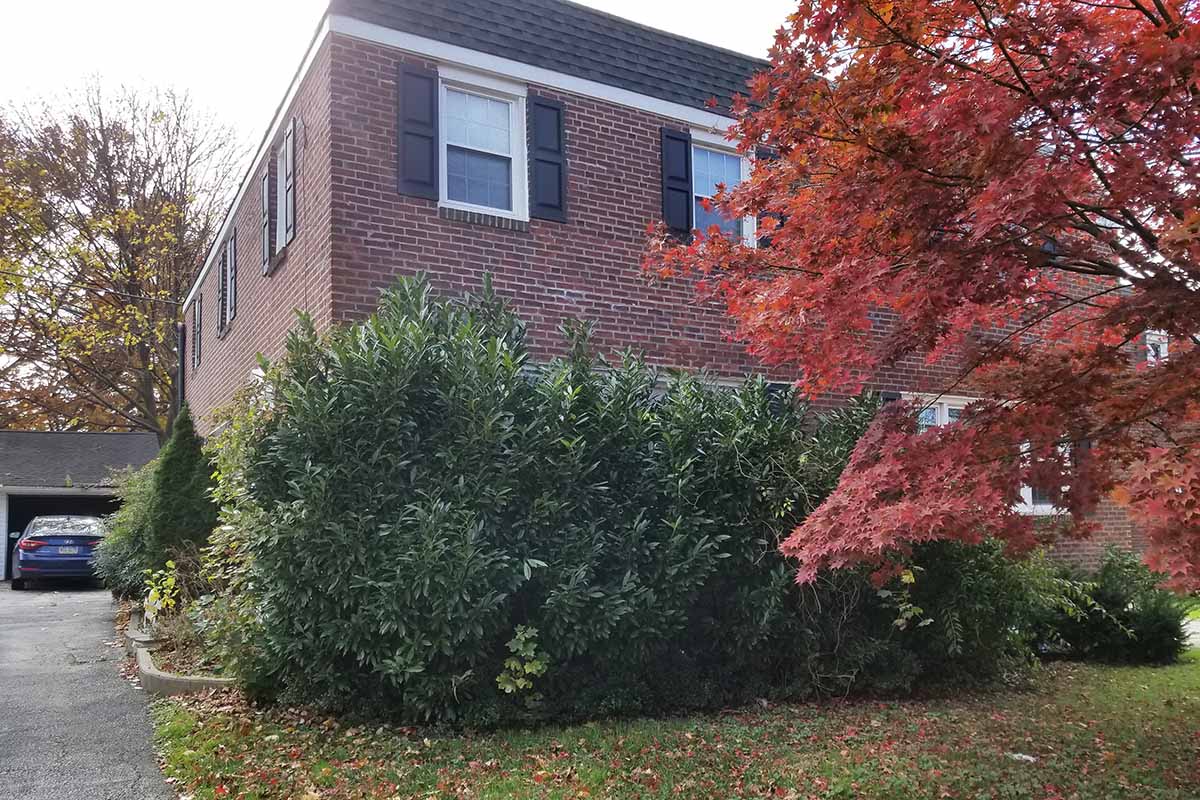
Our list of the best evergreen shrubs covers a wide range of USDA Hardiness Zones.
Each type of evergreen shrub listed below will have at least one recommended cultivar for you to grow in your yard, and they are organized by Zone, from coolest to warmest.
As a final note, double check your growing zone before making a purchase and ensure your new shrub is a match! Specific cultivars may have more narrow ranges.
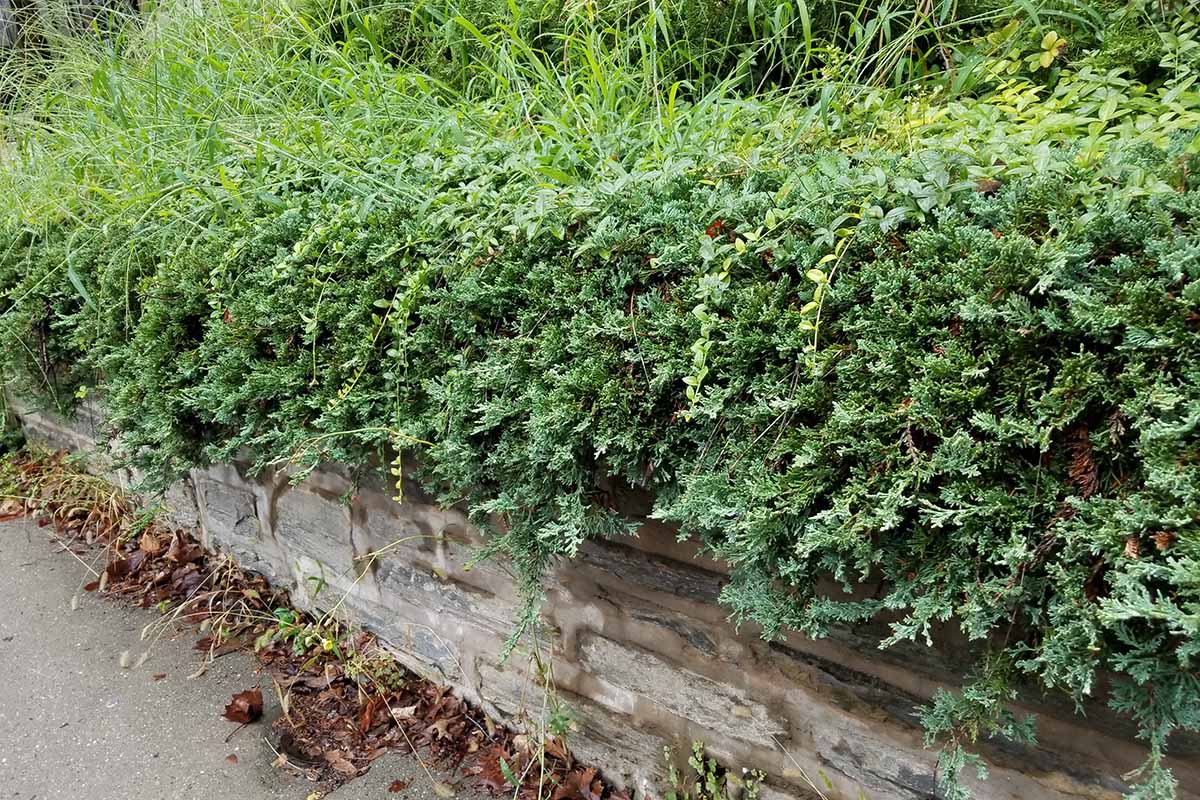
Let’s get right into it!
1. Leucothoe
A nice choice for areas ranging from the northeast to the southeastern United States, Leucothoe (Leucothoe spp.) is a hardy, native, and deer-resistant evergreen shrub that requires minimal special care.
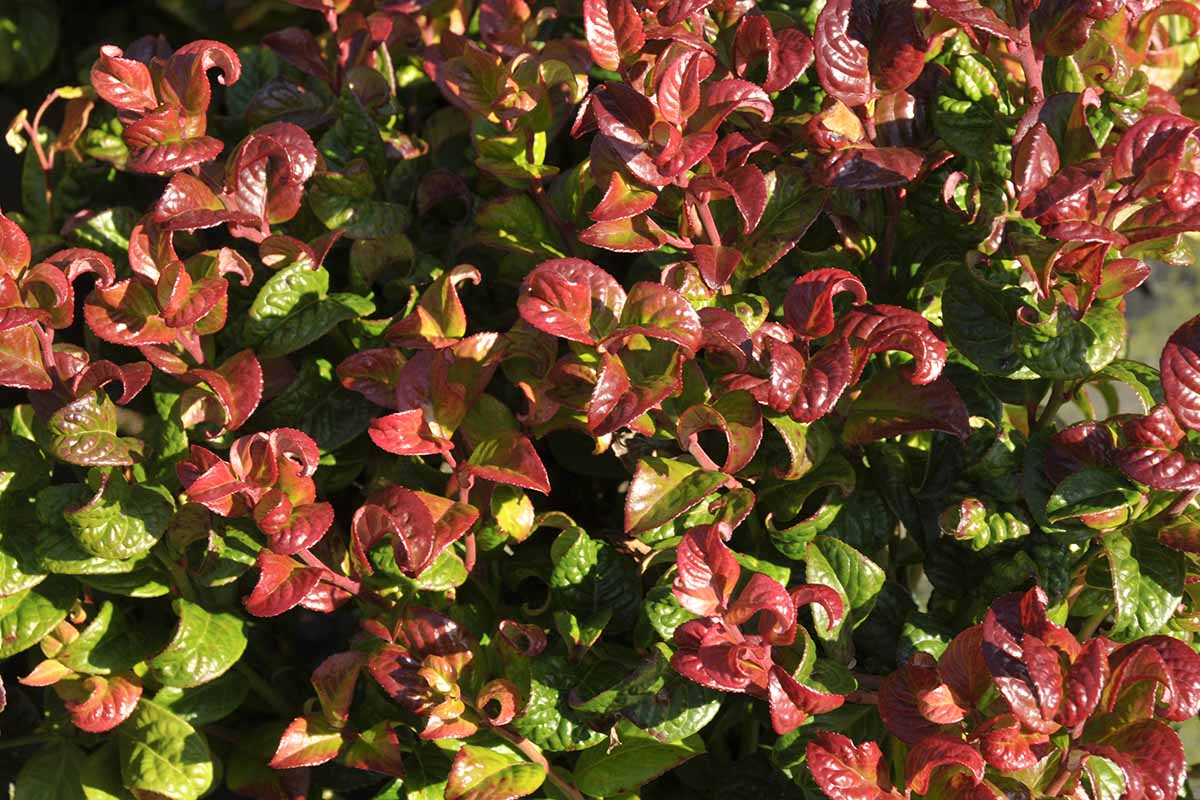
Better yet, it’s happy to spread beyond its initial planting area and is a great choice for a section of the garden where you have a lot of square footage to cover and are working on a budget.
Leucothoe adds a handsome dash of color, and provides you with excellent evergreen foliage.
I’m a fan of Leucothoe fontanesiana because of that gorgeous color the new foliage produces.
Check out your local nurseries for these guys, or try L. fontanesiana ‘Girard’s Rainbow,’ available from Nature Hills Nursery.
L. fontanesiana ‘Girard’s Rainbow’
This variety also tends to spread out quite happily and responds with minimal fuss to heavy pruning. I recently had to clear out over 50 percent of a hedge of L. fontanesiana and had zero hesitation doing it.
L. axillaris is the best native option to use if you’re interested in growing an all-native garden.
It is at its best in the southeastern United States, and offers handsome flowers and dependable foliage.
Squirt™ aka L. axillaris ‘Squzam’ is a compact cultivar that tops out at 18 to 24 inches with a width of two to three feet.
You can find this cultivar in #3 containers available at Nature Hills Nursery.
Growing Zones: Typically Zones 5 to 8
2. Cherry Laurel
Also known as Prunus laurocerasus, this is a favorite evergreen shrub in the Philadelphia region. Blame its popularity on the characteristic deep red berries it produces, or its eagerness to grow in warm and humid regions.
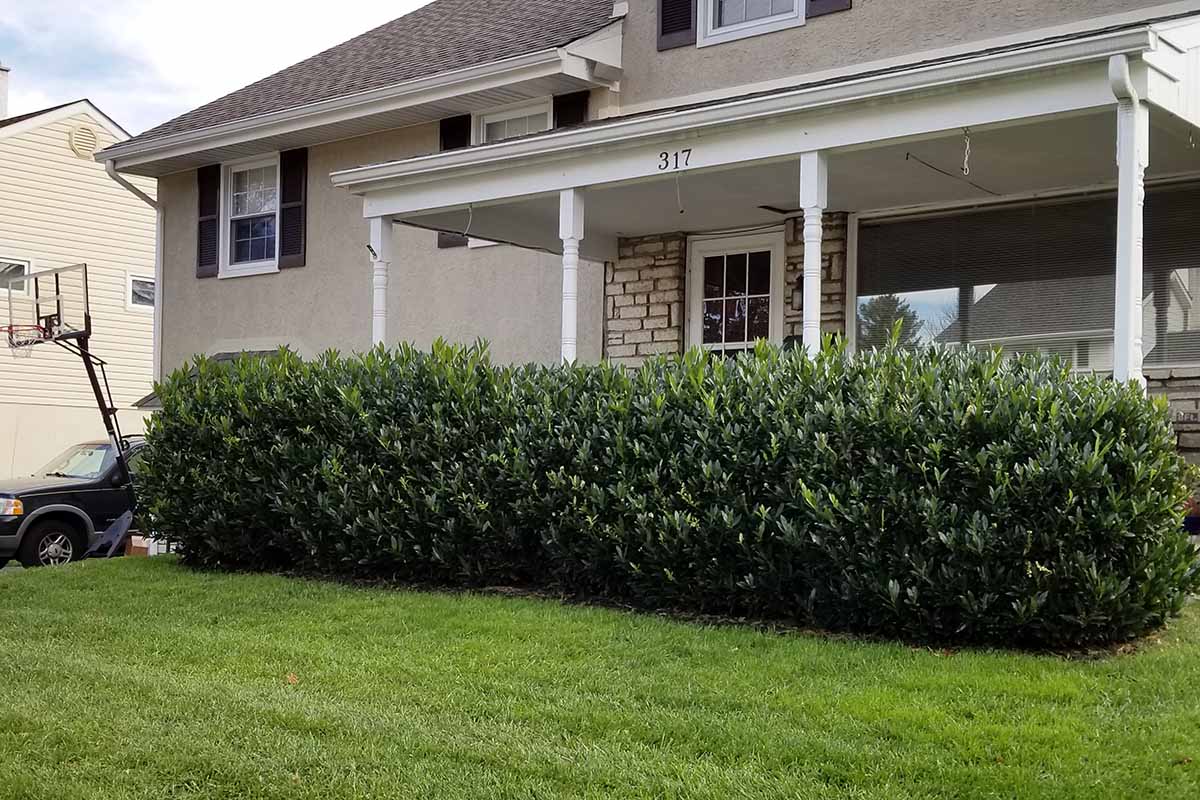
The plant is happy to stand upright, and resists most pests and problems.
The only problem I’ve run into is that P. laurocerasus is happiest in a warmer environment, and can suffer in the northernmost extent of its growing ranges.
Gardeners in the northern limits of the growing area for P. laurocerasus can expect to see some branch dieback during the winter, or wind burn in exposed areas.
P. laurocerasus aka Skip Laurel
You can pick up P. laurocerasus in a variety of sizes from FastGrowingTrees.com.
P. laurocerasus ‘Otto Luyken’ is an evergreen shrub that I have plenty of hands-on experience with.
The lovely white flowers give way to gorgeous black berries, and the persistently dark evergreen foliage of this cultivar offers tremendous value as a background plant wherever you need a backdrop of green with seasonal white flowers.
You can find ‘Otto Luyken’ available from Nature Hills Nursery.
Growing in an area with little natural sunlight? Consider P. laurocerasus ‘Chestnut Hill.’
One of our landscape architects favors ‘Chestnut Hill’ over almost all others, so even though I’m sick of seeing this evergreen shrub everywhere, it’s impossible to ignore its incredible value to the landscape.
It grows taller than other members of this species, and that’s valuable in and of itself!
Pick up ‘Chestnut Hill’ in #1 and #5 containers from Nature Hills Nursery.
Growing Zones: Typically Zones 6 to 9
Find tips on caring for cherry laurel bushes here.
3. Azalea
These are a favorite of mine for about… oh… two hundred and sixty-three reasons?
Azaleas grow well in a variety of conditions and promise beautiful spring blooms. Better yet, the difference between a shaggy azalea and a well-formed one is only a matter of basic pruning.
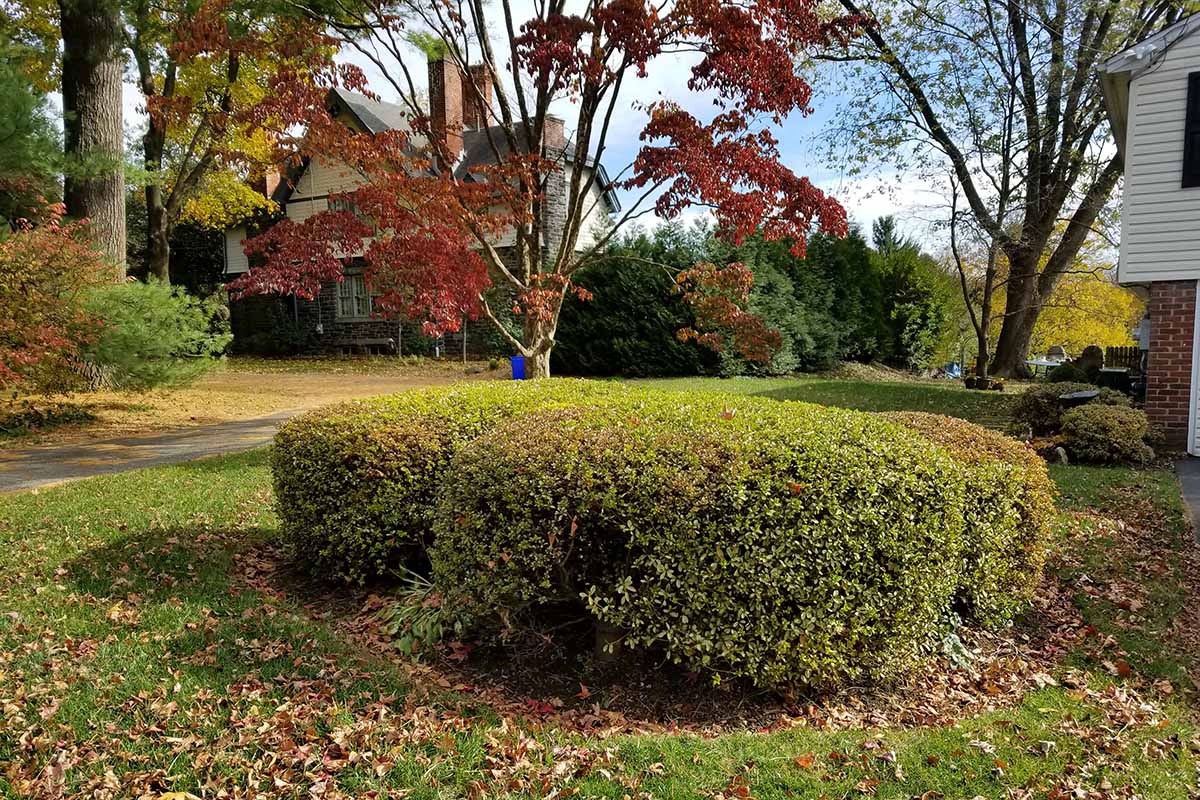
I find that an appreciation of the azalea’s natural tendency to be wild is best countered with fearless shaping.
I prune azaleas in the spring immediately after flowering, but will remove obnoxious or form-ruining shoots of growth as late as September.
Choosing an evergreen variety is important for year-long performance. The evergreen azaleas tend to have thicker, leathery leaves while the deciduous varieties have a softer and more delicate leaf.
Autumn Lily® aka Rhododendron ‘Roblex’ is an evergreen cultivar that sports creamy-white blooms in springtime. It reaches a mature height of about four feet with a similar spread.
You can find Autumn Lily® in #3 containers available at Nature Hills Nursery.
Growing Zones: Typically Zones 6 to 9
We have a guide on growing azaleas, complete with recommended cultivars, so check it out for more suggestions!
4. Yew
I love yew… that is, “yew” as in Taxus species – sorry if I got your hopes up!
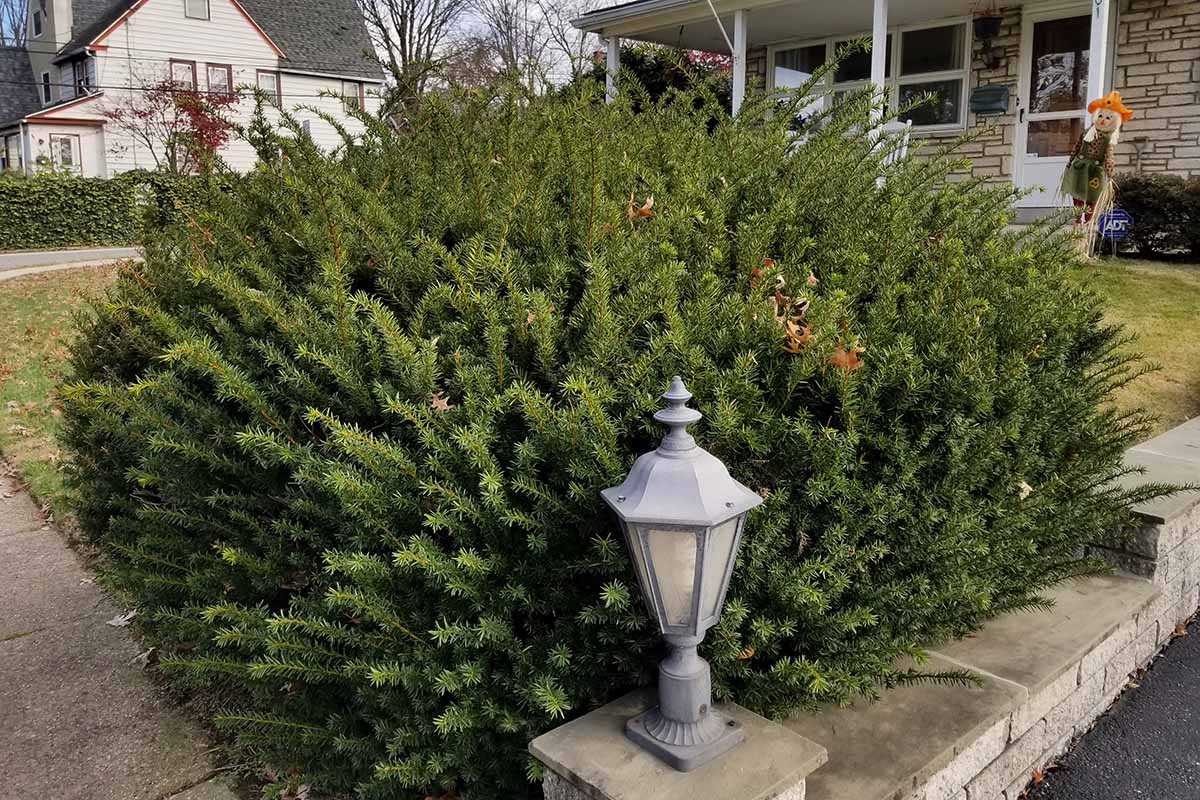
As far as reliable and handsome evergreen shrubs go, it’s hard to beat this one. It produces soft evergreen foliage as well as red berries (which contain toxic seeds) and its performance in the garden is stellar.
Some birds will eat the seeds of the yew, but these pass harmlessly through the digestive tract of the animal and cause no trouble.
While yew isn’t typically grown for its usefulness to wildlife, it doesn’t hurt to offer those birds something else to munch on.
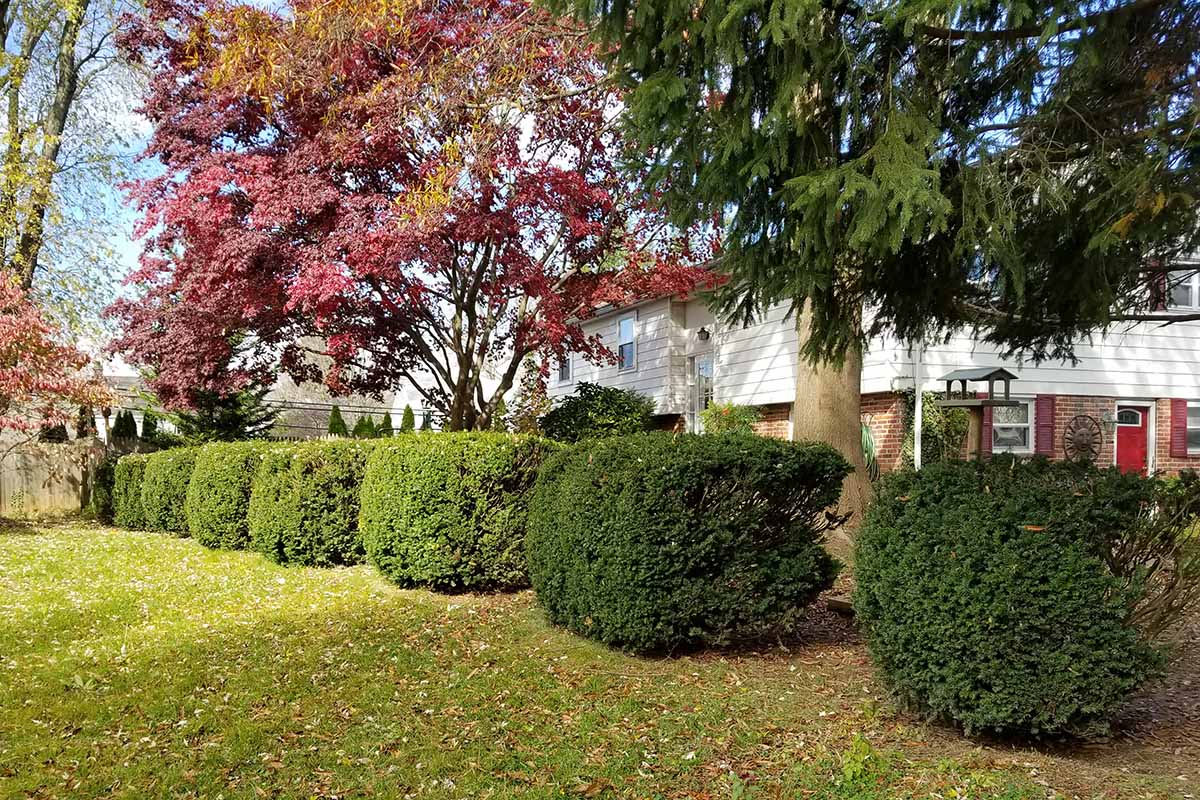
I had a family of sparrows living in a yew bush at my last apartment and they made great use of the branches as shelter, and surely nibbled on whatever berries they could find.
Yew responds very well to pruning and shearing, and can be shaped to whatever form you desire.
These tend to be pretty resistant to most ailments as well, which makes them an excellent worry-free evergreen shrub option for your yard.
The Taunton spreading yew (T. x media ‘Tauntonii’) is a good choice for informal areas. It tends to maintain a modest height of about four feet, and is happiest when it gets to go a little wild.
You can find ‘Tauntonii’ in #3 and #5 containers available at Nature Hills Nursery.
If you allow your ‘Tauntonii’ to grow free, you’ll see its branches develop into long “shoots” that have always reminded me of a porcupine.
I’ve used these in rock gardens and areas where too much formality isn’t necessary.
For a more formal and solid hedge, check out Hicks yew (T. x media ‘Hicksii’). It reaches a height of nearly 12 feet, and responds well to heavy pruning for growth as a formal privacy hedge.
Hicks yew grows across most of North America so it is perfect for many gardens, as long as they aren’t too wet!
You can pick up Hicks yew from Nature Hills Nursery in #3 containers.
Growing Zones: Typically Zones 4 to 7
Find more tips on growing and caring for yew here.
5. Euonymus
Euonymus for all of us! I like these guys because of the variety in form and color you can find, and except for being a bit messy, these evergreen shrubs aren’t plagued with pests and other problems.
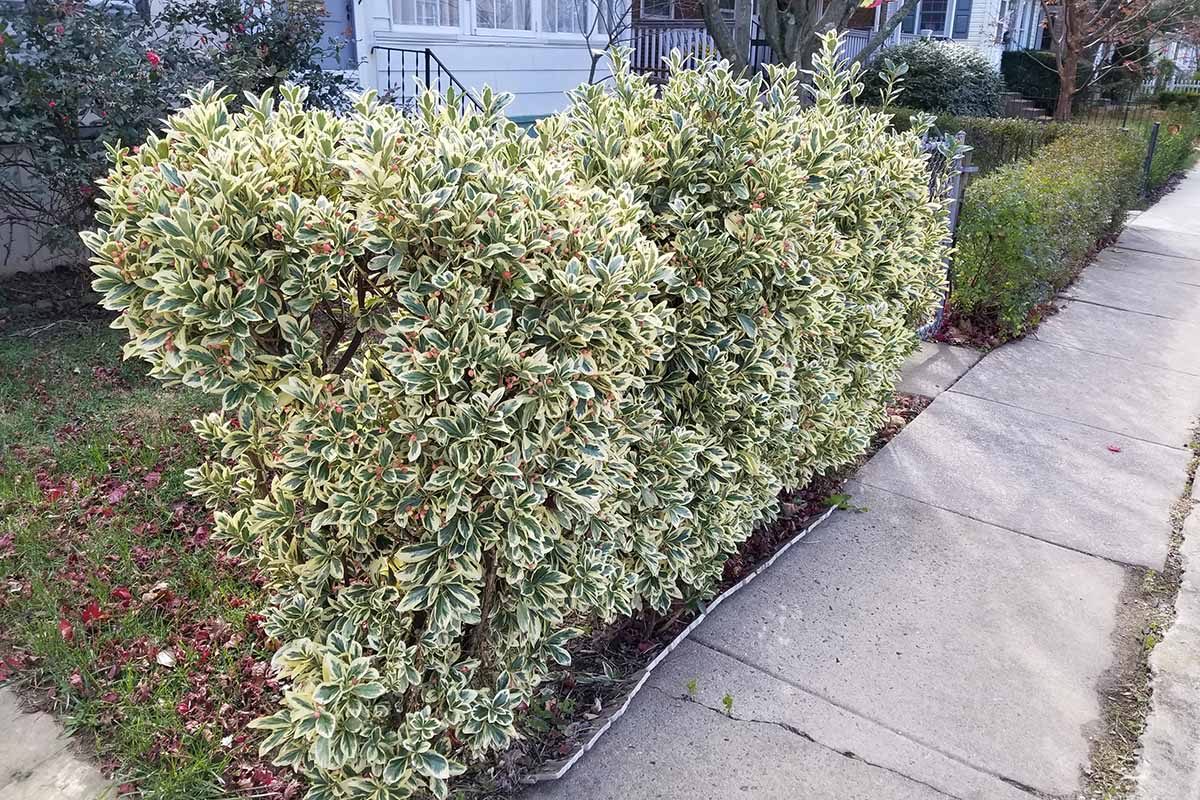
You can find tall and upright Euonymus species, as well low and controlled ones.
Most folks are familiar with the variety known as burning bush, but the evergreen varieties of this plant are where Euonymus is at its best.
Although the shrub seems to do best when it’s allowed to grow free and kind of wild, I’ve seen perfectly manicured Euonymus hedges before as well.
The handsome colors of this evergreen shrub are also easy to work with in the garden, and add plenty of variety and stable year-round color to your yard.
Euonymus kiautschovicus ‘Manhattan’ grows to six feet tall in Zones 5 to 10, and is a good option for warmer climates.
With a simple green leaf that’s still lustrous and handsome, it benefits from a bit of protection from strong winter winds to avoid leaf burn.
You can find ‘Manhattan’ in #3 containers available at Nature Hills Nursery.
For a shorter option, try E. fortunei ‘Emerald Gaiety.’ Not only does it offer a more modest height and spread than others, its soft colors promise to highlight and never detract from the rest of your garden.
You can find this cultivar available at Nature Hills Nursery in #2 containers.
This evergreen shrub can even become a climber if provided with the right supports, like a trellis or arbor!
Growing Zones: Typically Zones 5 to 9
Read more about growing and caring for Euonymus bushes here.
6. Mugo Pine
The mugo pine, or Pinus mugo, is a favorite of mine.
I don’t know why, exactly. It might be that it’s just a simple pine tree, and it might have something to do with its somewhat contorted growing habit, but I love this evergreen shrub.
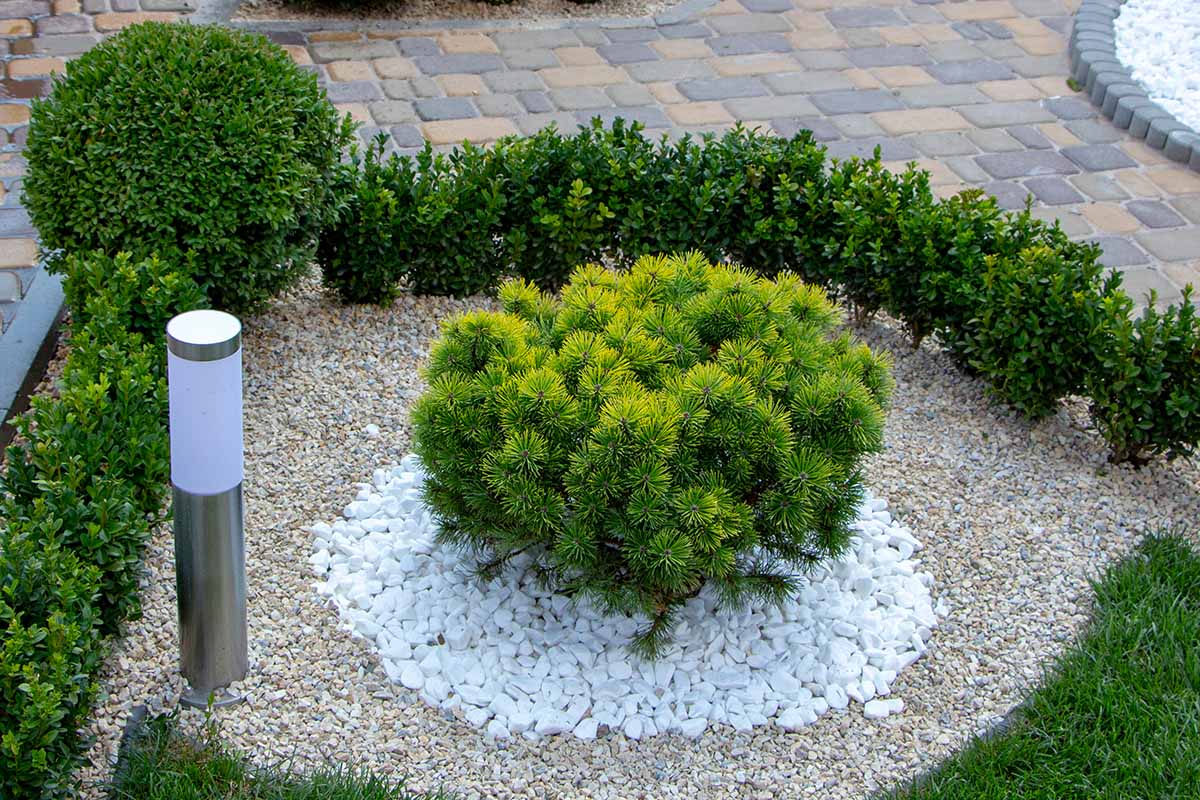
The mugo pine is great in rock gardens and gardens with an Asian theme, but it will thrive in just about any dry and rocky area.
If there’s a headache related to mugos, it’s that they can be pretty slow growing.
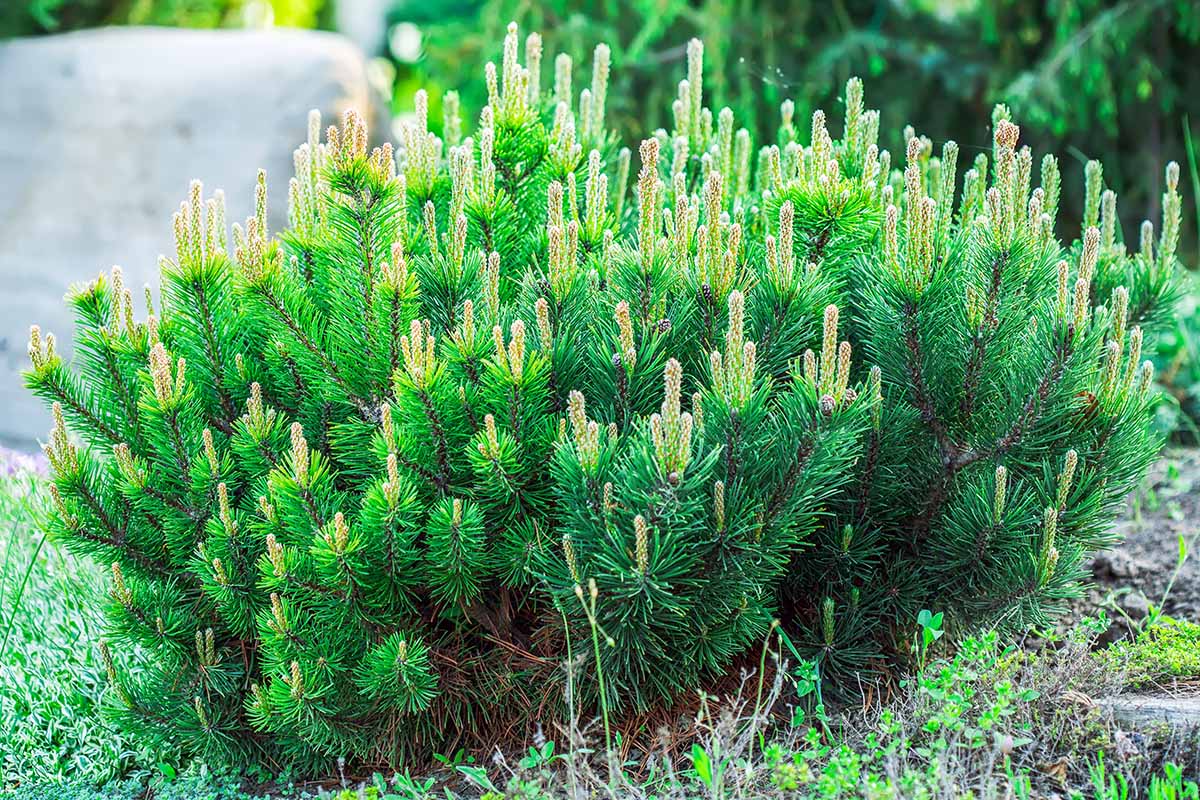
But that’s alright, since it’s hard to find a good evergreen shrub that looks as unique as a mugo and stays small and contained.
With a little bit of patience, you’ll have something that works as a statement piece while providing attractive background color.
My favorite option with this plant: the dwarf mugo pine (P. mugo var. pumilio). It’ll reach a height of about four feet and spreads out up to 10 feet.
You can find dwarf mugo pine available from Nature Hills Nursery.
Hardy and self-reliant, this is the perfect option for the garden when you want to plant it and forget it.
Growing Zones: Typically Zones 2 to 8
We delve deeper into mugo pines in our growing guide.
7. Pieris Japonica
Also known as Japanese adromeda or pieris, Pieris japonica is a lovely show-off of an evergreen shrub.
Whether you’re in it for the lustrous evergreen foliage highlighted with tinges of red and gold or the cascade of bell-shaped flowers, P. japonica deserves a place in your garden.

These evergreen shrubs prefer a shady spot where they will be protected from drying winds, and like to set roots into acidic soil.
Well-draining soil is preferred, to prevent nasty fungal infections, and this species is susceptible to many of the same conditions as azaleas.
More specifically, you’ll want to keep an eye out for powdery mildew, bark scale, whiteflies, and leaf miners, and calcium deficiencies.
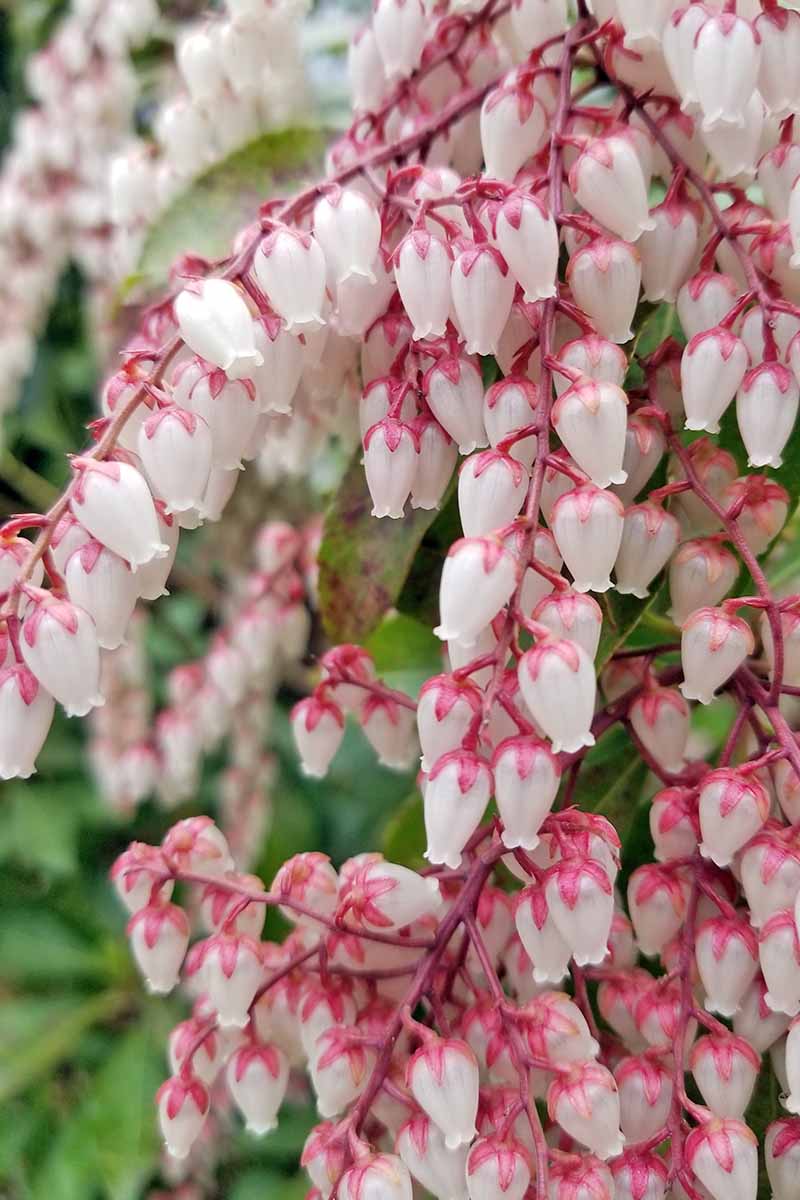
I’ve only seen pieris used as foundation points in the garden and never as a hedge, but it could be something worth pursuing!
Its colors are similar to that of Leucothoe and the two could make an interesting pairing in the garden.
Mountain Snow™ pieris (aka P. japonica ‘Planow’) is my personal favorite. It maxes out at a height of about five feet and has a similar spread, but the real appeal is the bright red color of new growth.
You can find Mountain Snow™ available at Plants by Mail.
Really a fantastic sight to behold in your own garden!
For a more restrained option, check out P. japonica ‘Cavatine.’
Its height of about two feet with a similar spread requires no special pruning, and its foliage maintains a green color accented with beautiful flowers.
A short row of ‘Cavatine’ is jaw-dropping when in full bloom.
Pick up this cultivar at Nature Hills Nursery.
Growing Zones: Typically Zones 5 to 9
8. Viburnum
The Viburnum genus offers a variety of evergreen options, and plants are usually quick to fill up space in the yard.
Because the list of available types of viburnum is huge, you’re just about guaranteed to find one that will be happy in your garden’s conditions.

Just keep an eye out when you’re purchasing these at a garden center or selecting one other than those on our suggested list. Some varieties of viburnum can grow to be huge and others are more deciduous in nature.
Still others can be pesky to prune, like the leatherleaf variety, because they produce an irritating sort of dust on the leaves.
This dust is easily visible when the leaves are shaken, and can make maintaining these shrubs an uncomfortable experience.
While the dust isn’t harmful, it is irritating, so I wear an isolation dust mask when working with them. Alternatively, spraying the foliage with a hose helps to minimize any falling dust.
Even so, these flowering evergreen shrubs are a solid choice for your yard and tend to be considerably resistant to pests and diseases.
They also take well to pruning and don’t require much more than some general maintenance, though thickly overgrown masses of viburnum may require heavier removal of old limbs.
Despite its drawbacks, I love the leatherleaf type (V. rhytidophyllum) as my evergreen viburnum of choice! It can reach a height of about ten feet and loves to spread out, sending up new leads of growth during every growing season.
It will bloom from May through June with clusters of fragrant yellowish-white flowers, and tapers off as the summer heat intensifies.
Leatherleaf Viburnum ‘Allegheny’
But these unassuming flowers do not detract from the rest of the garden. Prune them immediately after flowering, because viburnum starts setting new buds in the fall!
Pick up ‘Allegheny’ leatherleaf viburnum from Nature Hills Nursery in #3 containers.
Growing Zones: Typically Zones 3 to 9
Find more information about growing viburnum here.
9. Mahonia
One of my favorite evergreen shrubs, mahonia is a plant for people who want something tough and edgy that doesn’t skimp on visual appeal.
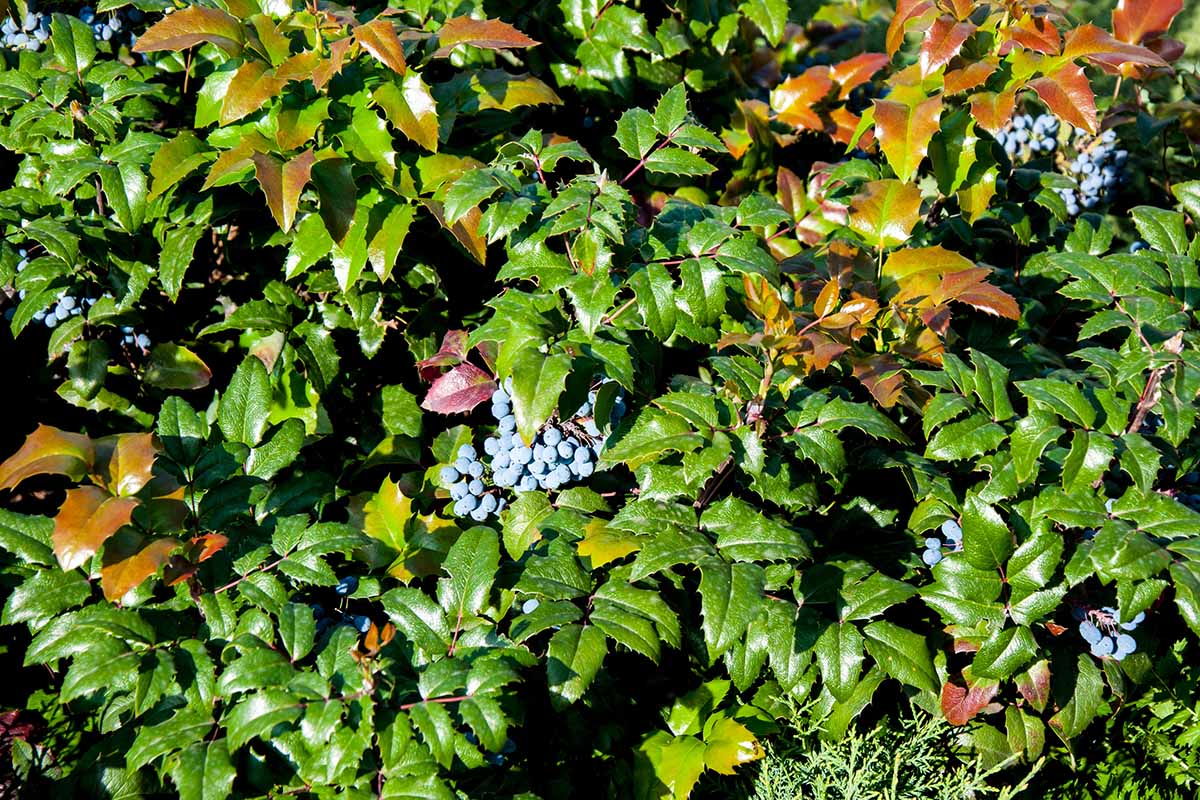
It looks like a short and stubby cross between a holly and a staghorn sumac, except it has some very lovely colors and fruits that add a nice accent to the dark green leaves.
But this is one prickly customer that isn’t for everyone, or for every location.
The leaves are rather sharp and pointed, and tend to aggravate anybody who handles them. It’s also simultaneously a slow grower and a plant that is all too happy to produce volunteer seedlings.
That said, if you’ve got room for a prickly evergreen shrub to ward off trespassers, or you simply want to add a bit of rough-and-tumble flavor to your yard, give mahonia a shot.
It’s handsome and worthwhile in its own way, and might be the perfect evergreen shrub for your home!
For a less prickly customer, consider Mahonia eurybracteata ‘Soft Caress.’ The leaves have less of an edge or point than other cultivars, and this variety is happy to grow in the shade.
It also has a short growth habit and spread, reaching about four feet tall and wide. The only hang-up is that it’s acclimated only to the narrow swath of Zones 7 to 9.
You can find ‘Soft Caress’ available in #3 containers from Nature Hills Nursery.
If you want the real deal, the species plant, M. aquifolium is available in three-gallon containers from FastGrowingTrees.com.
The plant will reach nearly eight feet in height and about six feet in width, producing beautiful bluish-purple berries that wildlife like small birds and insects adore.
Growing Zones: Typically Zones 5 to 9
Learn more about mahonia (Oregon grape holly) care here.
10. Boxwood
Our evergreen shrub roundup would not be complete without that trusty garden companion, the boxwood (Buxus spp.).
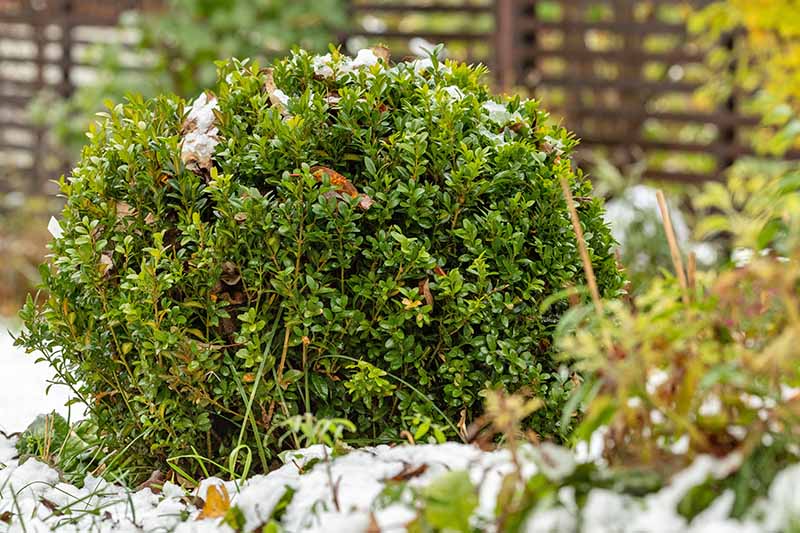
Now, I need to admit I have a certain distaste for boxwood because of how often I see it used on the properties where I garden, and you can only prune so many hundreds of them before you develop a similar distaste yourself.
But all of that aside, boxwoods are an ideal evergreen shrub because of their ease of growth, tendency to maintain a uniform growing pattern, and their eager response to pruning.
They maintain their color year-round, and are not typically not prone to many illnesses, though boxwood blight is typically fatal to these shrubs.
Use boxwood as a long hedge, or to add individual spots of green in your landscape. I like to think of them as giant green meatballs, dotting the yard. They work well in almost any capacity, and there are enough cultivars to find exactly what you need.
My personal favorite is B. microphylla var. japonica ‘Winter Gem’ because of its strong form and more appealing foliage.
These work ridiculously well as a long hedge of green meatballs, and are a breeze to prune.
They’re also stronger against winds, snowfall, and general abuse than other boxwoods I’ve worked with.
You can find ‘Winter Gem’ available from Nature Hills Nursery in #1 containers.
For a more conical plant, try B. x ‘Green Mountain.’
With softer foliage and a more upright growing habit, this is a good choice if you want to sprinkle a few around your yard as reliable and upright evergreen shrubs that don’t steal the show.
Pick up ‘Green Mountain’ in a choice of #1 or #3 containers from Nature Hills Nursery.
Growing Zones: Typically Zones 4 to 8
Read more about growing boxwood here.
11. Juniper
Juniper (Juniperus spp.) is an old favorite of mine. It was one of the first shrubs I worked extensively with on a tree nursery where I once worked, and I eventually came to savor the irritating feeling their needles provide to bare skin.
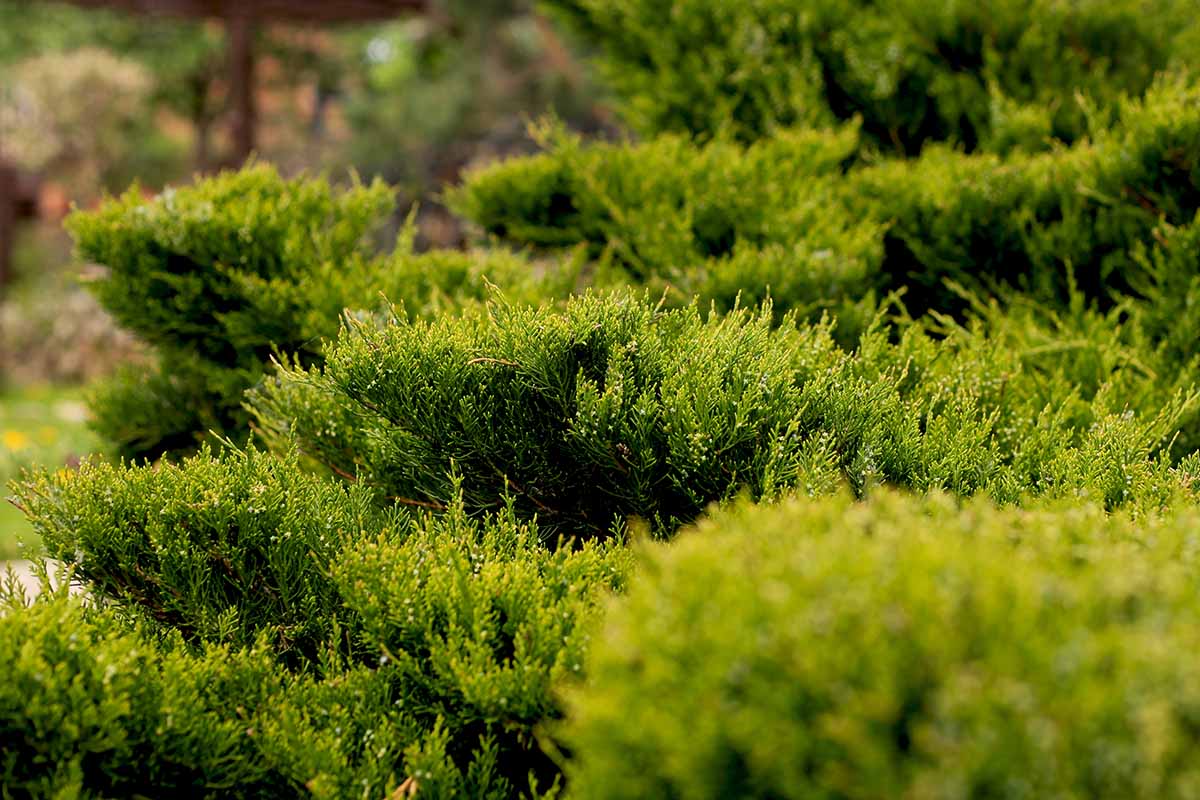
Add to those memories its absolute ease of growing, and you’ve got yourself a worthwhile evergreen shrub!
Variety could be juniper’s middle name. You’re able to find low-growing and ground-hugging varieties next to others that grow to become 100-foot-tall trees, and a huge variety of perfectly-sized evergreen shrubs for your yard.
If you’ve got a dry and rocky area where nothing seems to grow, pop in a juniper and watch it take off.
These shrubs are perfect for soil retention and as foundational hedges, though the low-growing varieties offer excellent evergreen ground cover.
My go-to favorite is ‘Blue Rug’ juniper (J. horizontalis ‘Wiltonii’) as both a ground cover and an accent in the garden.
It’s perfect for growing over and then cascading down a wall or arrangement of stone, and its short height of about six inches is offset by its spread of up to eight feet!
You could buy a handful of ‘Blue Rug’ junipers, available via Plants by Mail, and cover an entire area very quickly, all with a cool blue color.
If you prefer a plain green color, try J. chinensis ‘Sea Green.’ This cultivar reaches up to about six feet in height and is as easy to care for as they come.
You can find ’Sea Green’ available in #3 and #5 containers at Nature Hills Nursery.
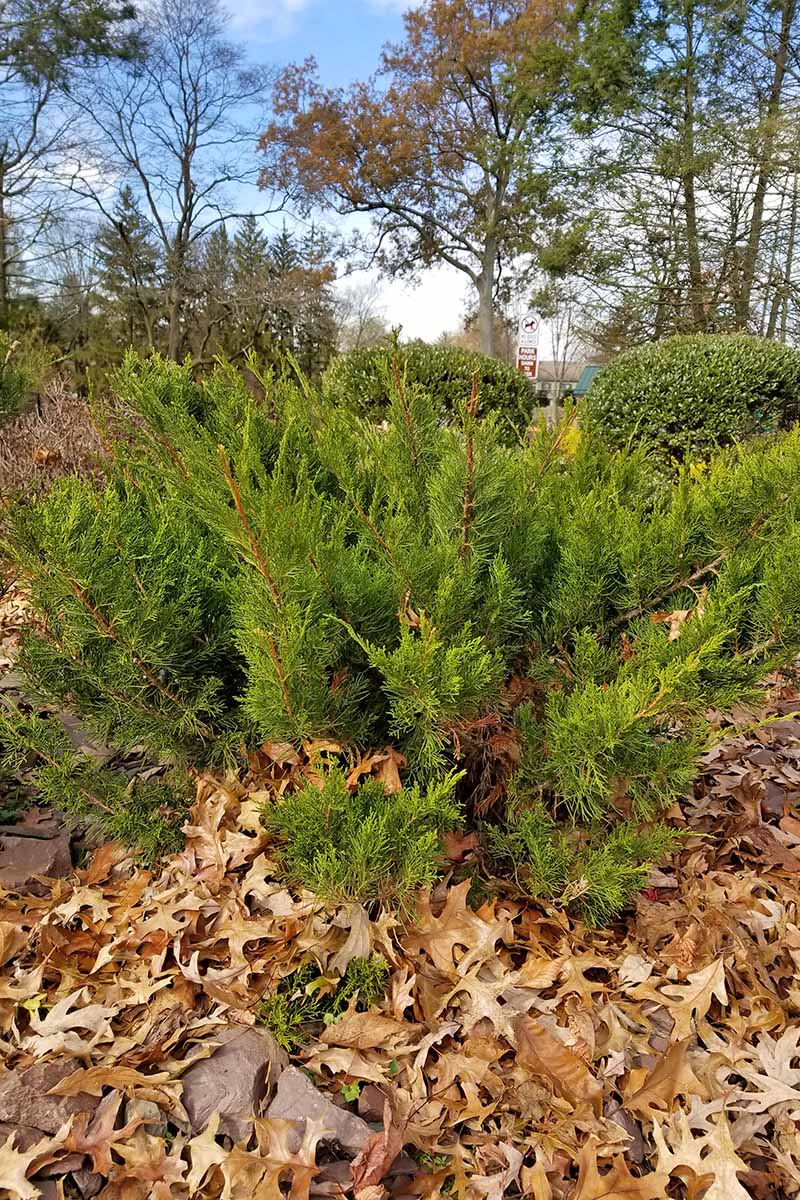
These will fill in areas quickly, so plant smartly! Its soft-textured foliage can hide foundations from view, and break up spaces dominated by structures like decks and other backgrounds as well.
Growing Zones: Typically Zones 2 to 8
Read more about growing junipers here.
12. Yucca
I’ll add some Yucca (Yucca spp.) to this list because they’re gorgeous, hardy, and produce one of the coolest flowers you’ll ever see!
Their status as “shrubs” might be up for debate, but in warmer regions of the country, this is a solid choice for year-round greenery.
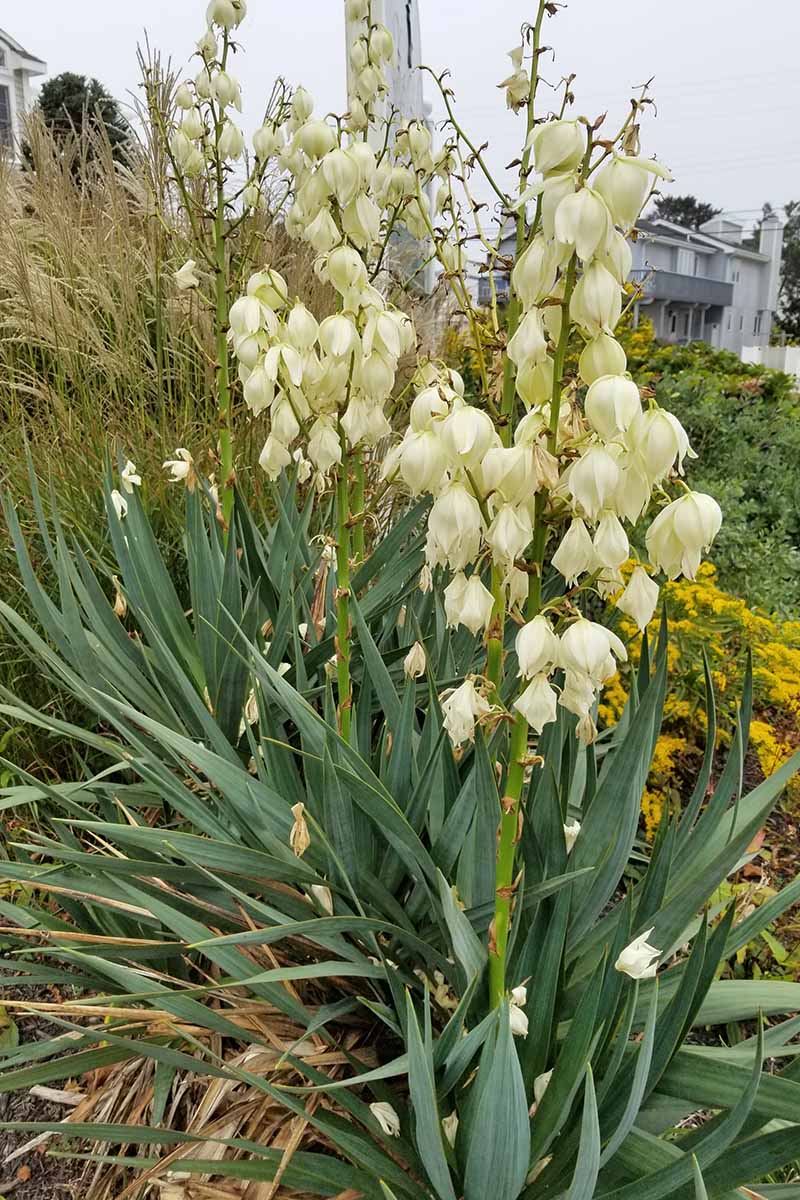
Sharp and upright rosettes of thick green leaves identify this plant, but its enormous flower stalk makes this an evergreen shrub that functions as the main act!
The foliage is unique among evergreen shrubs, and adds some fun variety to the texture of your garden.
They are highly resistant to… well, pretty much everything, and that’s a big plus in our book.
As the plants age and weather, they produce little twisted bits of fiber, making these a suitable option for those who don’t mind a wilder looking garden.
I’m a sucker for variegated plants, so Y. filamentosa ‘Color Guard’ is my first suggestion. Once established, it requires very little attention, and it can be divided every few years. It reaches a height of one to two feet. Not bad!
You can pick up ‘Color Guard’ in quart-sized containers from Nature Hills Nursery.
For a more uniform color, try Y. filamentosa aka Adam’s needle. The species plant from which the above described cultivar was derived, it produces an almost identical flower and reaches heights of two to four feet.
Stagger the two of these together, and you’ll find they nicely complement each other.
Pick up Y. filamentosa in #2 and #3 containers from Nature Hills Nursery.
Growing Zones: Typically Zones 4 to 10, might survive in Zone 11 in protected conditions
Find more info on yucca care here.
13. Rosemary
Our last is something most of us grow as an herb, but for gardeners way down in Zone 11, Salvia rosmarinus (syn. Rosmarinus officinalis) ‘Tuscan Blue’ can serve as an excellent evergreen shrub!
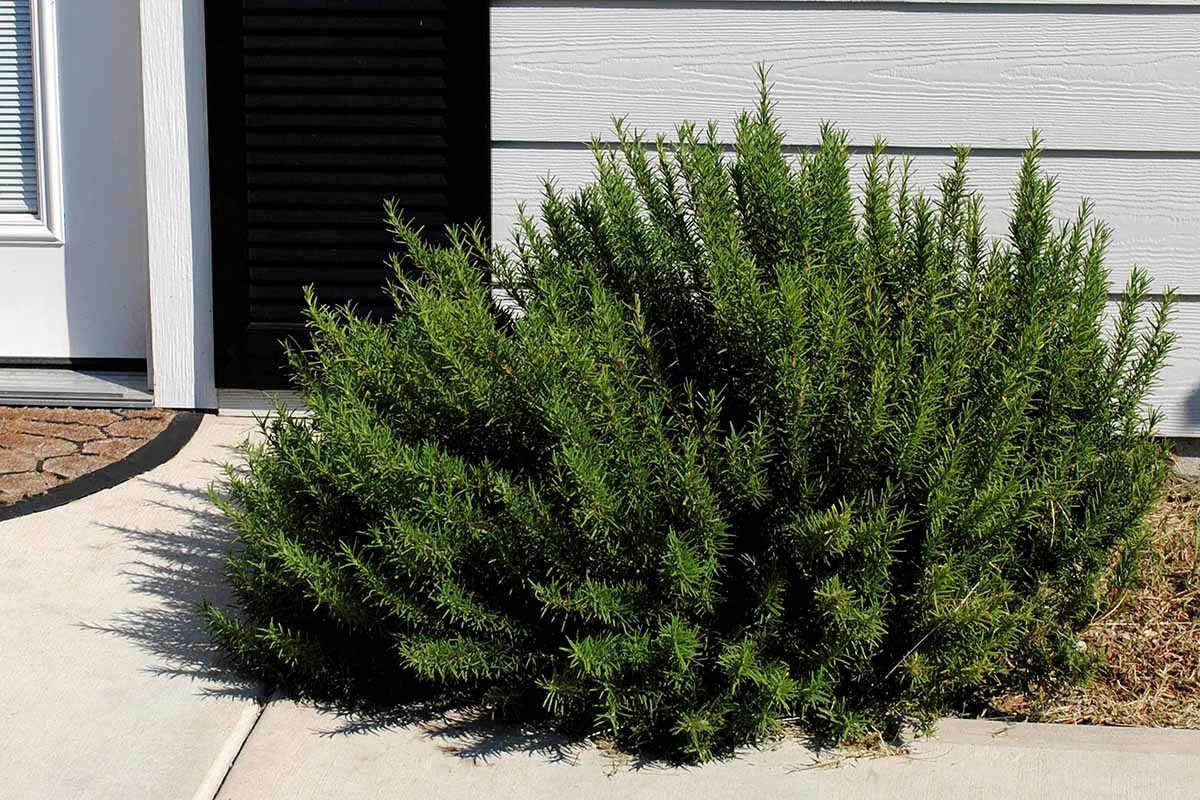
It is a plant that does not respond well to wet feet or cold conditions and prefers warmer, drier climates.
Rosemary can reach heights of six to 10 feet, and produces beautiful and delicate blue flowers. It’s one of the few evergreen shrubs that produces something edible and makes a worthwhile addition to a kitchen garden.
You can find ‘Tuscan Blue’ rosemary in #1 containers at Nature Hills Nursery.
Growing Zones: Typically Zones 8 to 11, might survive mild winters in Zone 7
Big, Green, and Reliable: Evergreen Shrubs Are the Way to Go!
Oftentimes, we think of evergreen shrubs as plain, boring background plants in the garden. And that’s true, to some extent.
A solid hedge of green or some reliable and easy-growing shrubs in the yard help bind everything together. But some of these can be showstoppers themselves, and that’s pretty great!

It’s impossible to put together a list of every single evergreen shrub out there, so I’ve focused on the ones I can personally recommend and endorse here. Which ones will you choose to add to your garden space?
Let us know! I’m always happy to read suggestions and questions in the comment section below.
For even more woody shrub suggestions for the garden, read these guides next:
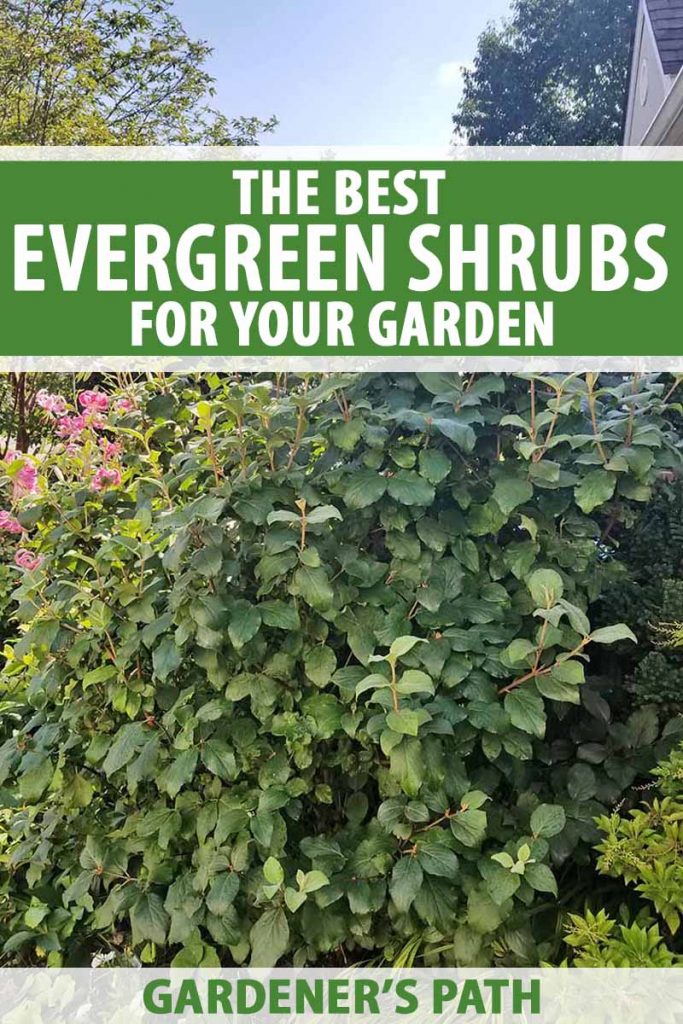
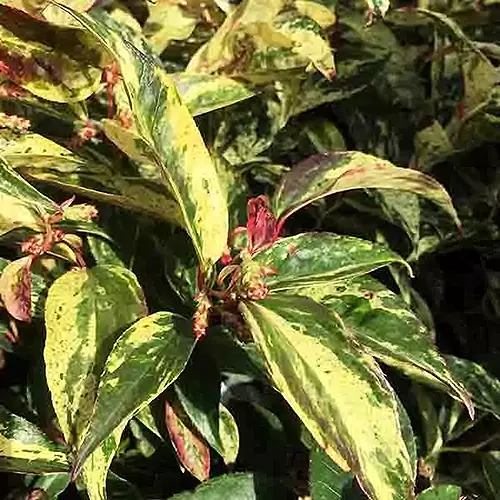
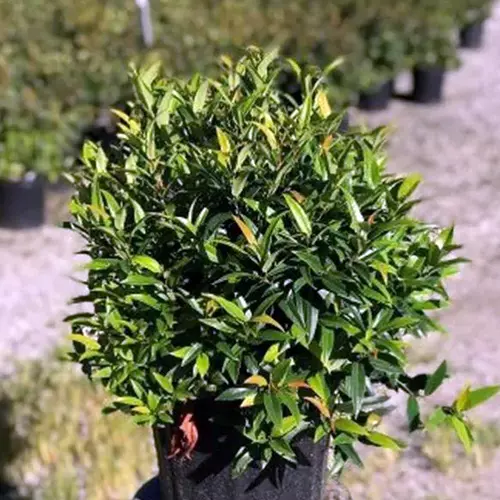
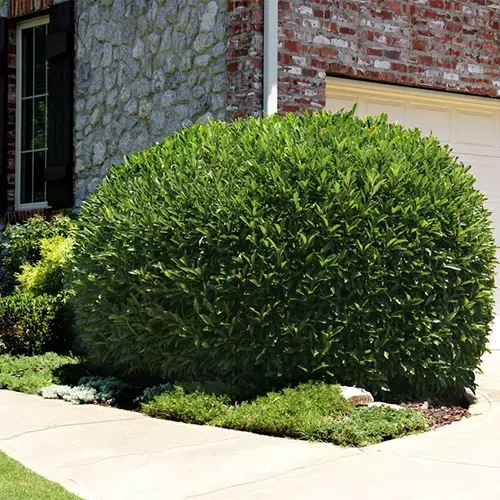
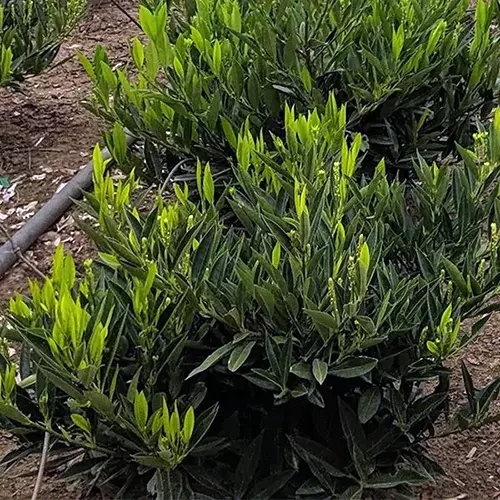
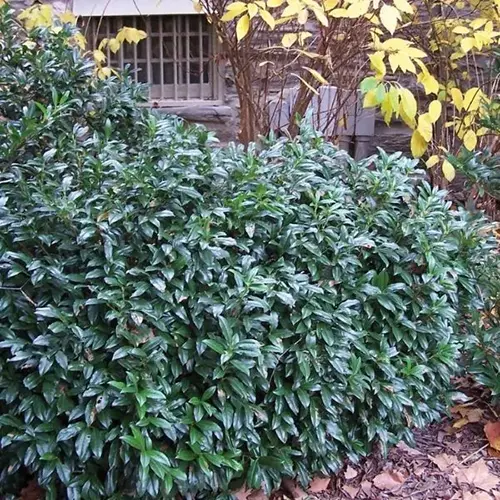
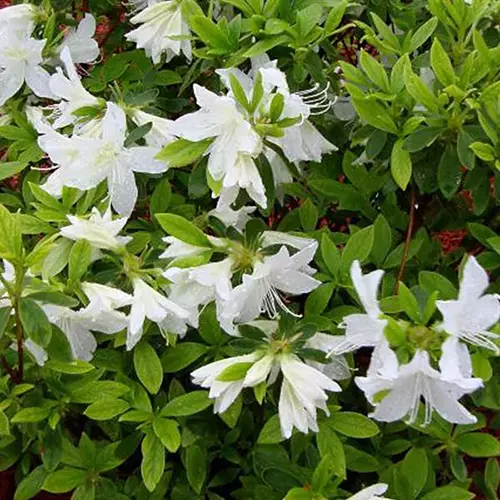
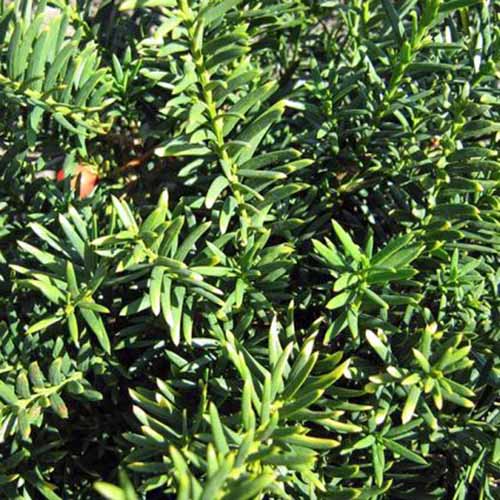
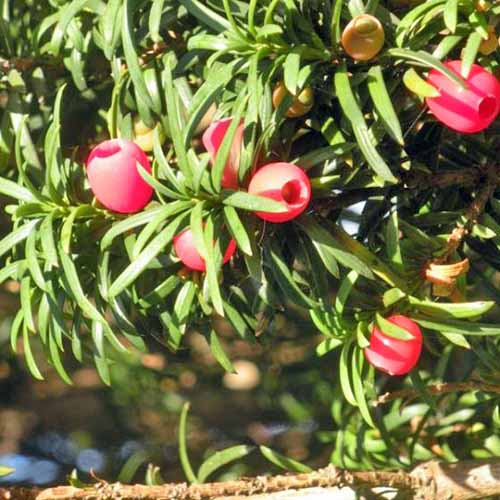
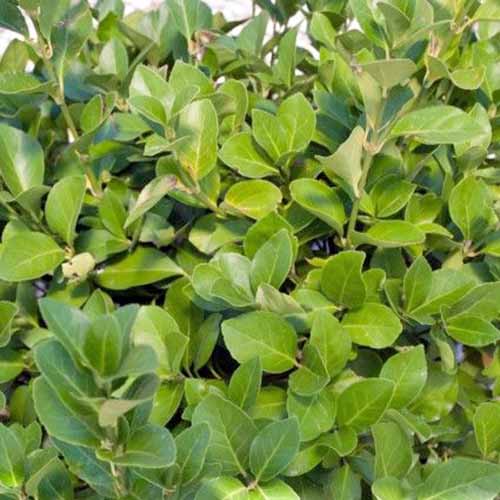
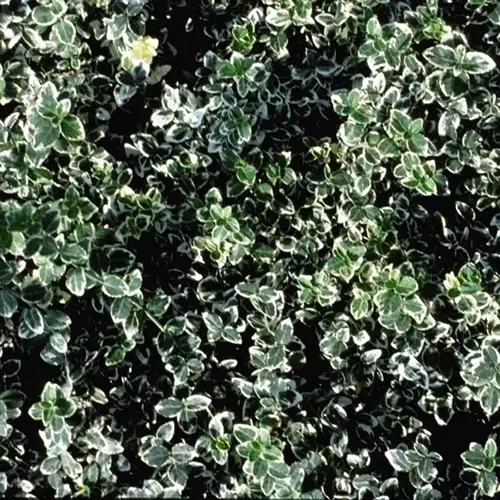
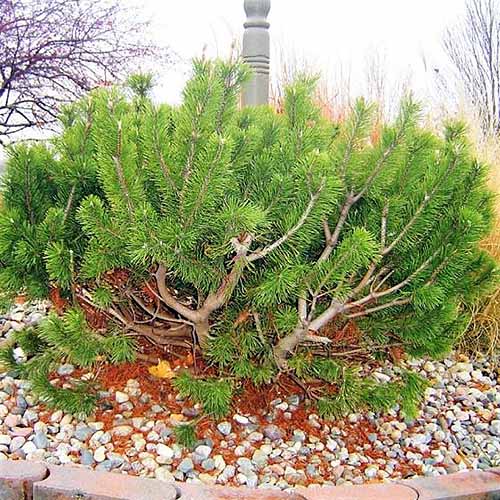
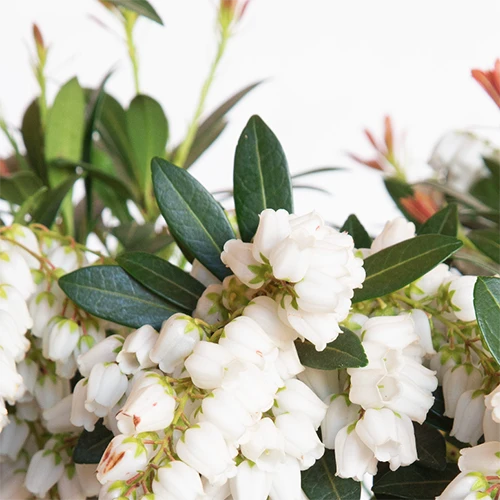
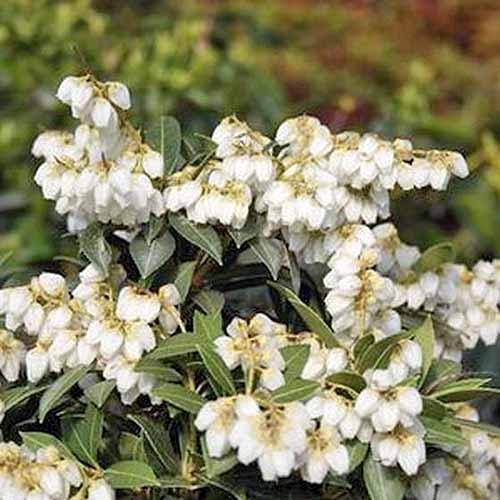
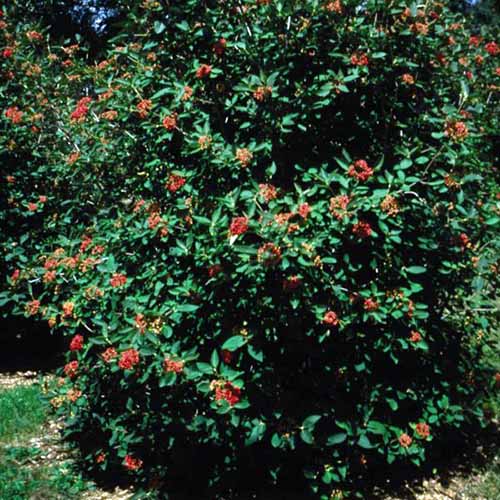
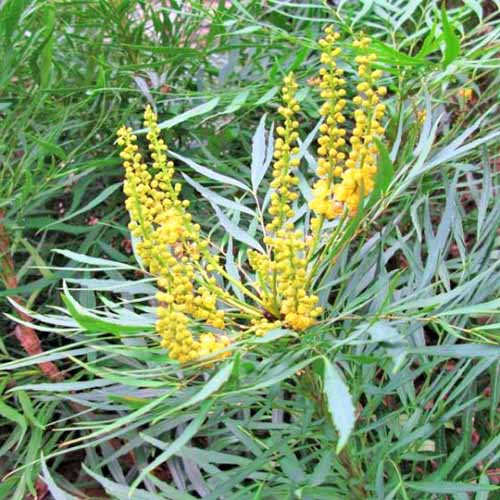
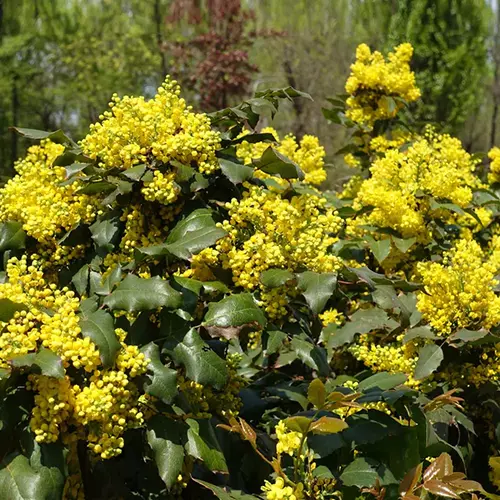
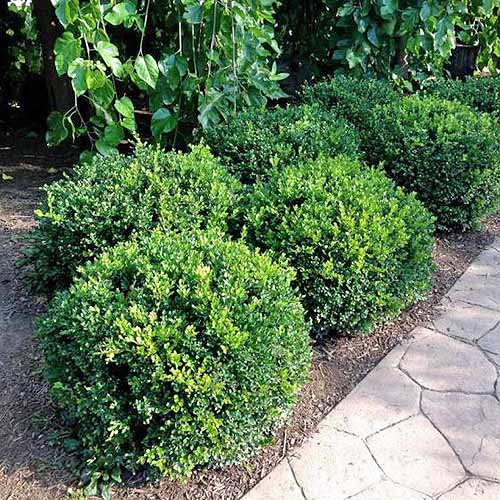
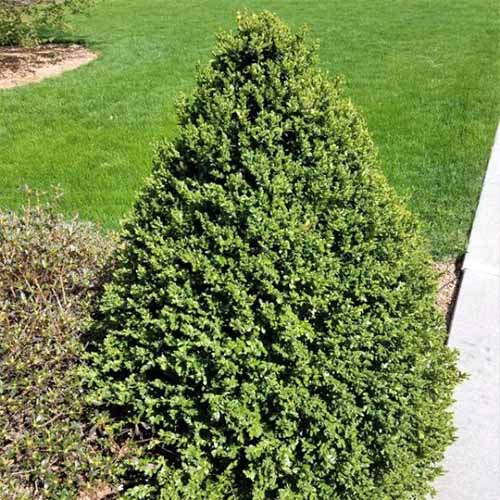
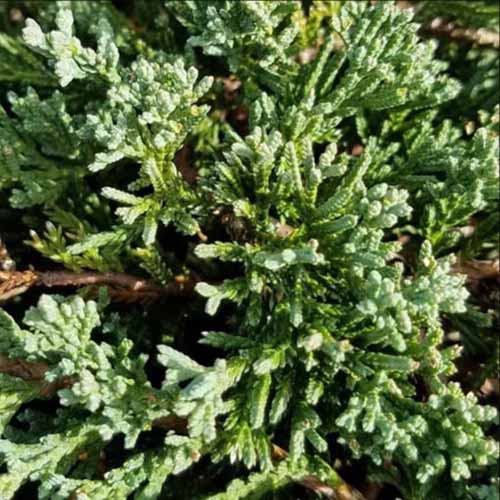
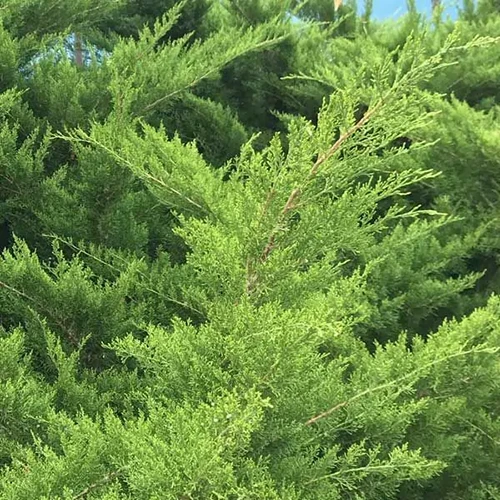
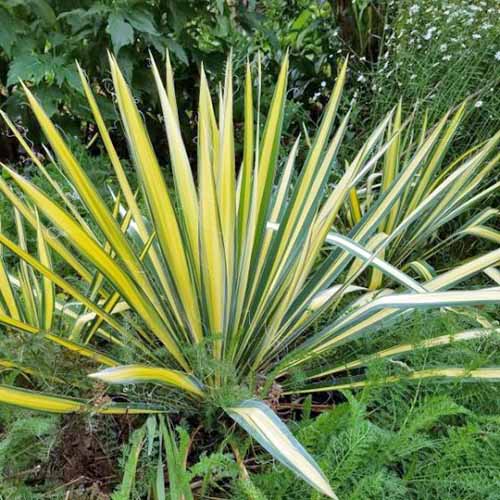
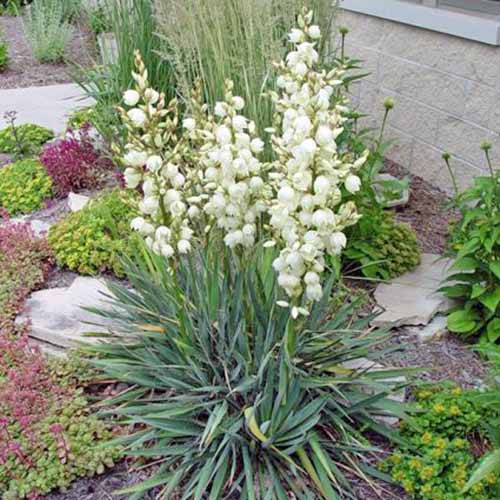
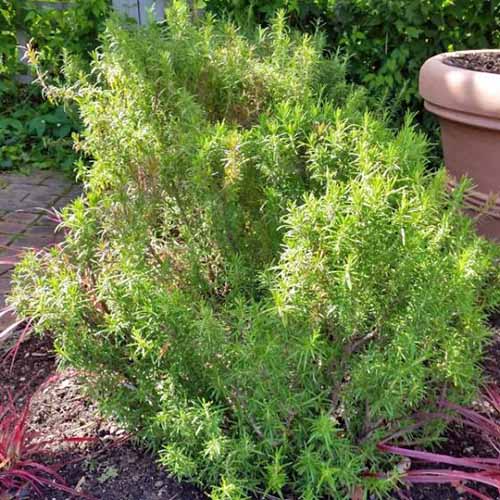
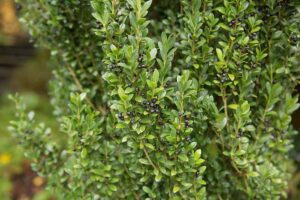
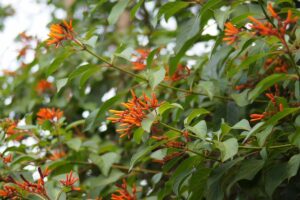
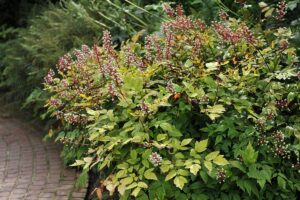
I would love to get some of the Oregon Grape Holly Fruit Vine Seeds because they look really amazing. I have clicked the link but for some reason it didn’t work. Could be my net though.
This link seems to be working from our end, Jeff. Please give it another try!
Hi Allison, I recently uprooted all of the bushes in front of my house. I did not realize what I was getting myself into at the time and now I am a bit stuck. Firstly, do I need to put something in the ground to kill the old roots (I pulled them out with a truck so most roots came out). Secondly do you have any suggestions of where to start with planting new bushes? The area is in full sun most of the day and Georgia weather. I want something different but not to crazy. Anyhow if you see… Read more »
What kind of evergreens did you pull up, James? It’s not common for evergreen shrubs to regrow from roots, so you shouldn’t have to worry about that. Early spring, when the weather is cool and rainy throughout many parts of the US, is usually recommended for planting new bushes, but in your area it may be better to wait until the fall. We’d be happy to offer some recommendations in terms of what to plant if you can let us know what you had in that spot previously! In Georgia you’re probably in USDA Hardiness Zone 7 or 8. Arborvitae… Read more »
I’d like to use Schip Laurel as a privacy screen but I’m allergic to bees. One article I read mentioned the plant has extrafloral nectaries on the back of young leaves that bees love. From your experience, do you notice the bees coming around only when the plant flowers in the spring or are they consistent throughout the year? Thanks for your input.
Sorry to hear about the bee allergy, Jen. Laurel may not be the best choice for you- these extrafloral nectaries can secrete nectar that is attractive to bees, wasps, and other types of beneficial insects independently of the bloom phase of the plant, so they will attract bees even when they’re not in flower.
Hello, This a good article. Would you please suggest what cloves you recommend that relatively completely protect your hard when handling these? Also, I am in Oregon, and I’m curious what plans would you recommend to provide a barrier against cats walking into my property, and Also, that would be appropriate to provide some kind of a barrier from people picking into my windows, but from the other perspective that I could see through, like rose stems, and identify if there is someone standing? So in essence, you could see through from the inside of a house, but hard to… Read more »